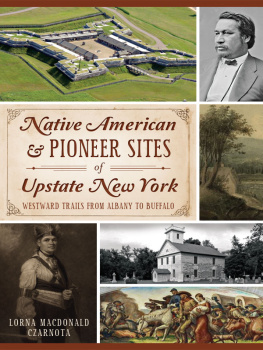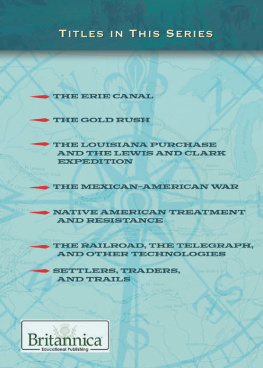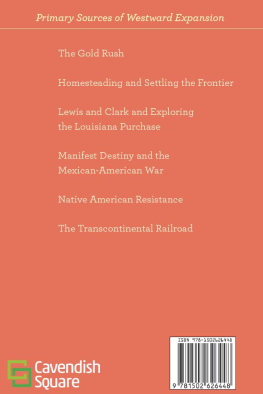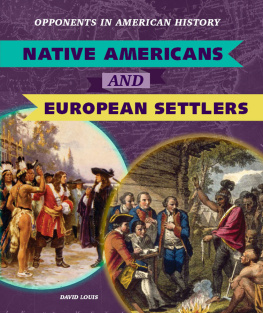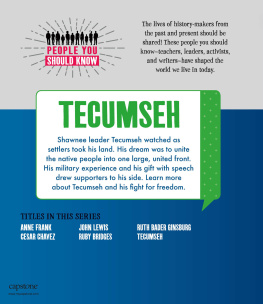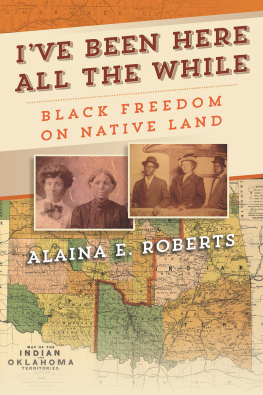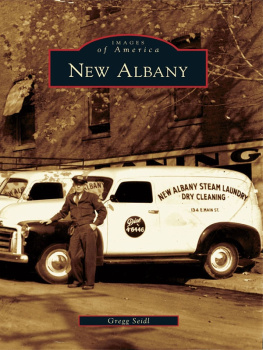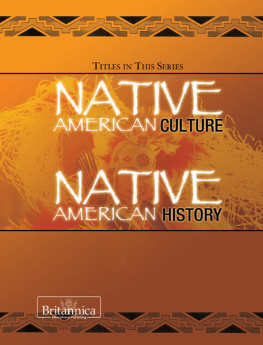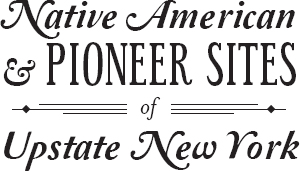

Published by The History Press
Charleston, SC 29403
www.historypress.net
Copyright 2014 by Lorna MacDonald Czarnota
All rights reserved
First published 2014
e-book edition 2014
ISBN 978.1.62584.776.8
Library of Congress Cataloging-in-Publication Data Czarnota, Lorna.
Native American and pioneer sites of upstate New York : westward trails from Albany to Buffalo / Lorna Czarnota.
pages cm
Includes bibliographical references and index.
print edition ISBN 978-1-62619-290-4
1. Upstate New York (N.Y.)--History, Local. 2. Trails--New York (State)--Upstate New York--History. I. Title.
F126.8.C93 2014
974.7--dc23
2014005158
Notice: The information in this book is true and complete to the best of our knowledge. It is offered without guarantee on the part of the author or The History Press. The author and The History Press disclaim all liability in connection with the use of this book.
All rights reserved. No part of this book may be reproduced or transmitted in any form whatsoever without prior written permission from the publisher except in the case of brief quotations embodied in critical articles and reviews.
Dedicated in memory of Mom and Dad, for curiosity, imagination, creativity and a lifelong desire to learn. More thanks than I can ever express. You are missed.
CONTENTS
ACKNOWLEDGEMENTS
I wish to thank the historians and writers who have collected information online and in books about the regions encompassing Routes 5 and 20. Also, thanks to all the entrepreneurs and docents with whom I have spoken over the phone and in person.
Thank you to my editor, Whitney Tarella Landis, Jaime Muehl and the designers from The History Press who always create a beautiful product.
Special thanks to Karen Osburn, archivist for Geneva Historical Society; Glenn Bentz, Iroquois reenactor; James at Avon Historical Society; Pat Reynolds, owner of American Hotel in Lima; and Steve, manager of Holloway House in Bloomfield.
Extra special thanks to the many friends who helped find images for the book, especially Susanna Connelly Holstein, Daniel P. Bronson, Charles Burke and Joan Oblinsky Scharf. Thanks to friend and local artist Alice Gerard for her sketches.
And thank you to my best friend and life partner, Thomas Heim, for the many photographs, keen eye and constant support.
INTRODUCTION
Adventure is worthwhile in itself.
Amelia Earhart
People who have never been to New York State often think only in terms of New York City, imagining the state to be one large suburb when in fact much of it is very different from the city. The state is mostly rural, bookended by its two largest cities, New York and Buffalo, with Syracuse, Rochester, Binghamton and Albany vying as mid-range urban communities. Many smaller villages lay scattered across the stateor rather, less scattered than purposely placed. The purpose of this book is to explain why these villages exist, how they got their names, what sustained early settlers and what these communities offer us today.
There is no doubt Native American peoples lived in a symbiotic relationship with the environments of New York State. Their many villages are now gone, blended back into the land that they respected. However, their story is not forgotten thanks to the hard work of archaeologists, historians and modern-day Native Americans who work tirelessly to keep that story alive.
We should also remember the early immigrants, who came to find freedoms the Old World did not afford them, and their influences on New York States landscape. They dared to leave behind the familiar to carve a new nation. While some came because they had no choice and others came for profit, all loved the wilderness beauty they found.
Influenced by water, social change and technological advances, villages grew following the Revolutionary War and during the Industrial Revolution, as well as during the Second Great Awakening. They survived or dwindled yet all have rich legacies in their historical archives. We must know and tell these stories, for they are the foundations of whom we have become.
It is undeniable that building the Erie Canal changed New York State, as did Interstate 90. Today, the Interstate extends over three hundred miles from Buffalo to the Massachusetts border. Using the Thruway makes it easy to bypass the small towns and cities in favor of speed and better gas mileage; however, travelers and history buffs miss a great deal of old-town charm in doing so. Many of the villages located on the two most traveled eastwest roads were cutting edge when first settled. Bypassing them changed their faces but not their stories or heritage.
It was not my intention to leave any stories or communities out of this book; however, there are far too many villages and hamlets to mention them all. Hopefully, enough have been included to give a good sense of what it was like living in New York States wilderness and in villages as they formed, grew or waned. The stories included are a blend of fact and legend, with every effort taken to ensure they are correct.
Most importantly, this book is intended to entice travelers to look deeper at our history and recognize the significant roles these smaller towns played in forging New York States character. Follow the footsteps of those who came before by way of the westward trails from Albany to Buffalo.
Please visit the authors website for additional photos and stories: www.lornamacdonaldczarnota.com.
ROADS TO A BRAVE NEW WORLD
Once, everything west of Albany was a vast wilderness. With expansion westward shortly after the American Revolution, settlers had two choices of how to cross the state: by waterway or overland. Once simple animal trails and Native American footpaths, Routes 5 and 20 are major thoroughfares today.
Routes 5 and 20, the westward trails, wind between forested hills, previously home to the Iroquois Confederacy. They meander through fertile farmland and utopian playgrounds of the rich. They pass fine vineyards, beautiful Finger Lakes, the Erie Canal, outstanding classical and Victorian architecture and very near to Great Lakes Ontario and Erie. The sites and homes of many Native Americans, early settlers, national heroes, entrepreneurs and inventors overlook these roadways. Who were these people, why did they come here, where have they gone and what legacies have they left us?
Route 5
The stories of Routes 5 and 20 are both shared and unique. These two roads are co-joined for approximately seventy miles from Auburn to Avon. Routes 5 and 20 also travel solo beginning east and west of these two villages. Where Route 20 begins in Massachusetts, Route 5 is born in Albany. Route 5 and its twin, 5S, lazily parallel the Mohawk River until Route 5 veers off toward Syracuse. Route 20, on the other hand, snakes through the countryside, touching the Finger Lakes on its way to Buffalo and beyond. Route 5 is Main Street throughout much of Western New York, including Batavia, Clarence, Williamsville and Buffalo, to its end near the Pennsylvania border.
Since roads are man-made, they are subject to mans needs and the changes wrought by them. Current-day Route 5 was once called Route 5A. Previously, it was located where current Route 7 can be found. Name changes took place in the 1920s.
Todays Route 5, called the Kings Highway during British rule, is an identical parallel to the Great Genesee Road, named as such in 1794, following the Revolution. This road was also known as the Mohawk Trail, Iroquois Trail, Great Indian Trail or Seneca Turnpike. Great Genesee Road predates Route 5 by one hundred years or more. Some of this old road later incorporated Route 5 so that they are indistinguishable. Also following old Indian trails, the Great Genesee Road continued west beyond settled lands as far as Fort Niagara. As a formal road, it was meant to serve lands granted to soldiers who participated in the Revolutionary War. It connected Fort Schuyler (Utica, New York) with what is now Caledonia (Canawaugus) in Livingston County. Land companies responsible for handling these grants or tracts demanded better roadways. As a result, four years after being established, the Great Genesee Road was improved and extended to Buffalo. A year prior to its extension, in 1797, a weekly stagecoach began running, eventually leading to many inns and the stagecoach stops servicing them. Of course, when businesses thrive, people begin to build nearby, and towns spring up around them.
Next page
